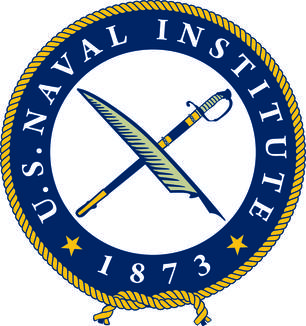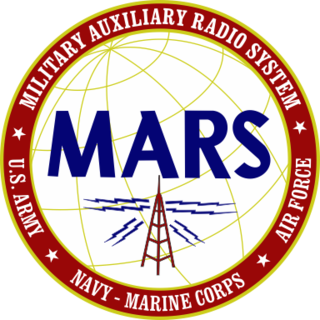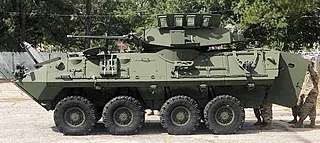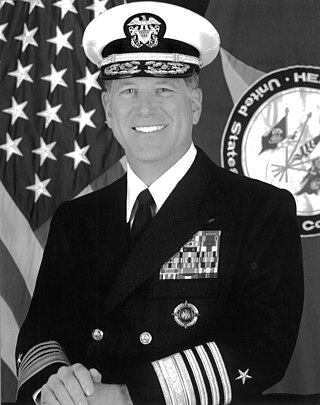The United States has eight federal uniformed services that commission officers as defined by Title 10 and subsequently structured and organized by Titles 10, 14, 32, 33 and 42 of the U.S. Code.

The heavily indebted poor countries (HIPC) are a group of 39 developing countries with high levels of poverty and debt overhang which are eligible for special assistance from the International Monetary Fund (IMF) and the World Bank.

The Fleet Marine Force Combat Operation Insignia is a miniature 5⁄16 inch bronze United States Marine Corps emblem that may be authorized by the Secretary of the Navy for wear on specific campaign, expeditionary, and service medal ribbons issued to United States Navy sailors attached to and on duty with Fleet Marine Force (FMF) units during combat operations and sailors on duty with Navy units attached to and operating with Fleet Marine Force units while under Marine Corps operational control during combat operations. The device was instituted in 1953 with the Navy and Marine Corps Award Manual dated 1953.

A Reserve Good Conduct Medal refers to any one of the five military conduct awards, four of which are currently issued and one of which was previously issued, by the United States Armed Forces to members of the Reserve and National Guard. The primary difference between the regular Good Conduct Medal and the Reserve Good Conduct Medal is that the regular Good Conduct Medal is only issued for active duty service while the reserve equivalent is bestowed for reserve duties such as drills, annual training, and additional active duty for either training or operational support to the active duty force or, in the case of the Army National Guard and Air National Guard, in support of Title 32 U.S.C. state active duty (SAD) such as disaster response and relief.
The United States Navy Working Capital Fund (NWCF) is a branch of the family of United States Department of Defense (DoD) Working Capital Funds. The NWCF is a revolving fund, an account or fund that relies on sales revenue rather than direct Congressional appropriations to finance its operations. It is intended to generate adequate revenue to cover the full costs of its operations, and to finance the fund's continuing operations without fiscal year limitation. A revolving fund is intended to operate on a break-even basis over time; that is, it neither makes a profit nor incurs a loss.

The United States Naval Institute (USNI) is a private non-profit military association that offers independent, nonpartisan forums for debate of national security issues. In addition to publishing magazines and books, the Naval Institute holds several annual conferences. The Naval Institute is based in Annapolis, Maryland.
An exchange is a type of retail store found on United States military installations worldwide. Originally akin to trading posts, they now resemble contemporary department stores or strip malls. Exact terminology varies by armed service; some examples include base exchange (BX), and post exchange (PX), and there are more specific terms for subtypes of exchange.

The United States Navy Reserve (USNR), known as the United States Naval Reserve from 1915 to 2005, is the Reserve Component (RC) of the United States Navy. Members of the Navy Reserve, called Reservists, are categorized as being in either the Selected Reserve (SELRES), the Training and Administration of the Reserve (TAR), the Individual Ready Reserve (IRR), or the Retired Reserve.

The Military Auxiliary Radio System (MARS) is a United States Department of Defense sponsored program, established as a separately managed and operated program by the United States Army, and the United States Air Force. The United States Navy-Marine Corps program closed in 2015. The program is a civilian auxiliary consisting primarily of licensed amateur radio operators who are interested in assisting the military with communications on a regional and national level when access to traditional forms of communication may no longer be available. The MARS programs also include active duty, reserve, and National Guard units; and Navy, Marine Corps units.

The LAV-25 is a member of the LAV II family. It is an eight-wheeled amphibious armored reconnaissance vehicle built by General Dynamics Land Systems and used by the United States Marine Corps and the United States Army.

The Armed Forces Retirement Home refers to one of two Old Soldiers' retirement homes, one in Gulfport, Mississippi, the other in Washington, D.C., that house veterans and active duty members of the United States Armed Forces.

A military reserve force is a military organization whose members (reservists) have military and civilian occupations. They are not normally kept under arms, and their main role is to be available when their military requires additional manpower. Reserve forces are generally considered part of a permanent standing body of armed forces, and allow a nation to reduce its peacetime military expenditures and maintain a force prepared for war. During peacetime, reservists typically serve part-time alongside a civilian job, although most reserve forces have a significant permanent full-time component as well. Reservists may be deployed for weeks or months-long missions during peacetime to support specific operations. During wartime, reservists may be kept in service for months or years at a time, although typically not for as long as active duty soldiers.
The Marine Corps Association is the professional organization for members of the United States Marine Corps and friends of the Corps. It is known for its publications Leatherneck Magazine and Marine Corps Gazette. As of 2009, MCA became part of MCA&F, the Marine Corps Association & Foundation.

Charles Stevenson "Steve" Abbot is a retired United States Navy Admiral who served as Deputy Commander in Chief, United States European Command (DCINCEUR) from 1998 to 2000.

Jerome LaMarr Johnson is a retired four-star admiral of the United States Navy who commanded the United States Second Fleet, Joint Task Force 120, and NATO's Striking Fleet Atlantic from 1988 to 1990. He served as Vice Chief of Naval Operations from 1990 to 1992.

The Marine Forces Reserve, also known as the United States Marine Corps Reserve (USMCR) and the U.S. Marine Corps Forces Reserve, is the reserve force of the United States Marine Corps. It is the largest command, by assigned personnel, in the U.S. Marine Corps. Marines in the Reserve go through the same training and work in the same Military Occupational Specialties (MOS) as their active-duty counterparts. The United States Marine Corps Reserve was established when Congress passed the Naval Appropriations Act of 29 August 1916, and is responsible for providing trained units and qualified individuals to be mobilized for active duty in time of war, national emergency, or contingency operations.

The Coast Guard Mutual Assistance (CGMA) is an independent non-profit charitable organization of the United States Coast Guard. As the official relief society of the United States Coast Guard, the organization assists those within the Coast Guard family. This includes active duty and retired military members, Coast Guard civilian employees, Coast Guard Reserve, Coast Guard Auxiliary, Public Health Service officers serving with the Coast Guard, and surviving family members. It has provided more than $230 million in financial assistance since 1924.

An officer is a person who holds a position of authority as a member of an armed force or uniformed service.
The National Defense Cadet Corps (NDCC) was the forerunner to the current Junior Reserve Officers' Training Corps (JROTC) program and is essentially identical to it with just one exception: The NDCC is funded internally by the schools that opt for a military training system like JROTC but without any financial assistance from the Department of Defense. Therefore, the schools bear all costs associated with the program, including military instructor salaries, uniforms, training materials, and any other program expenses. As of 2012, there were three remaining US Army NDCC units in the United States. The US Navy began its program in April 2011. The US Marine Corps and the US Air Force also operate NDCC programs.














